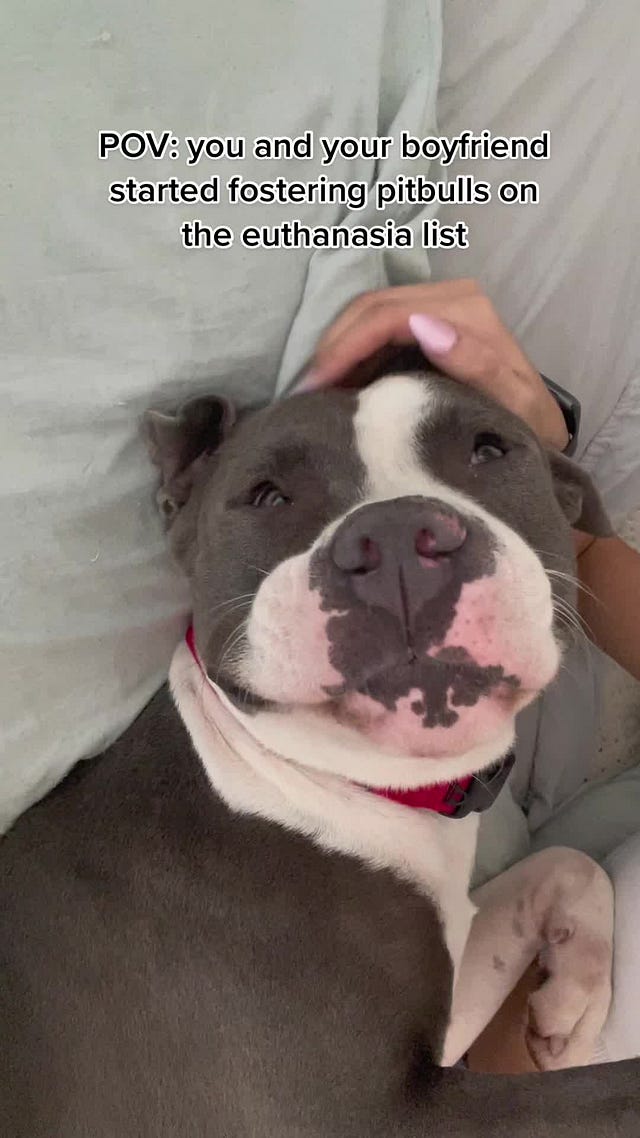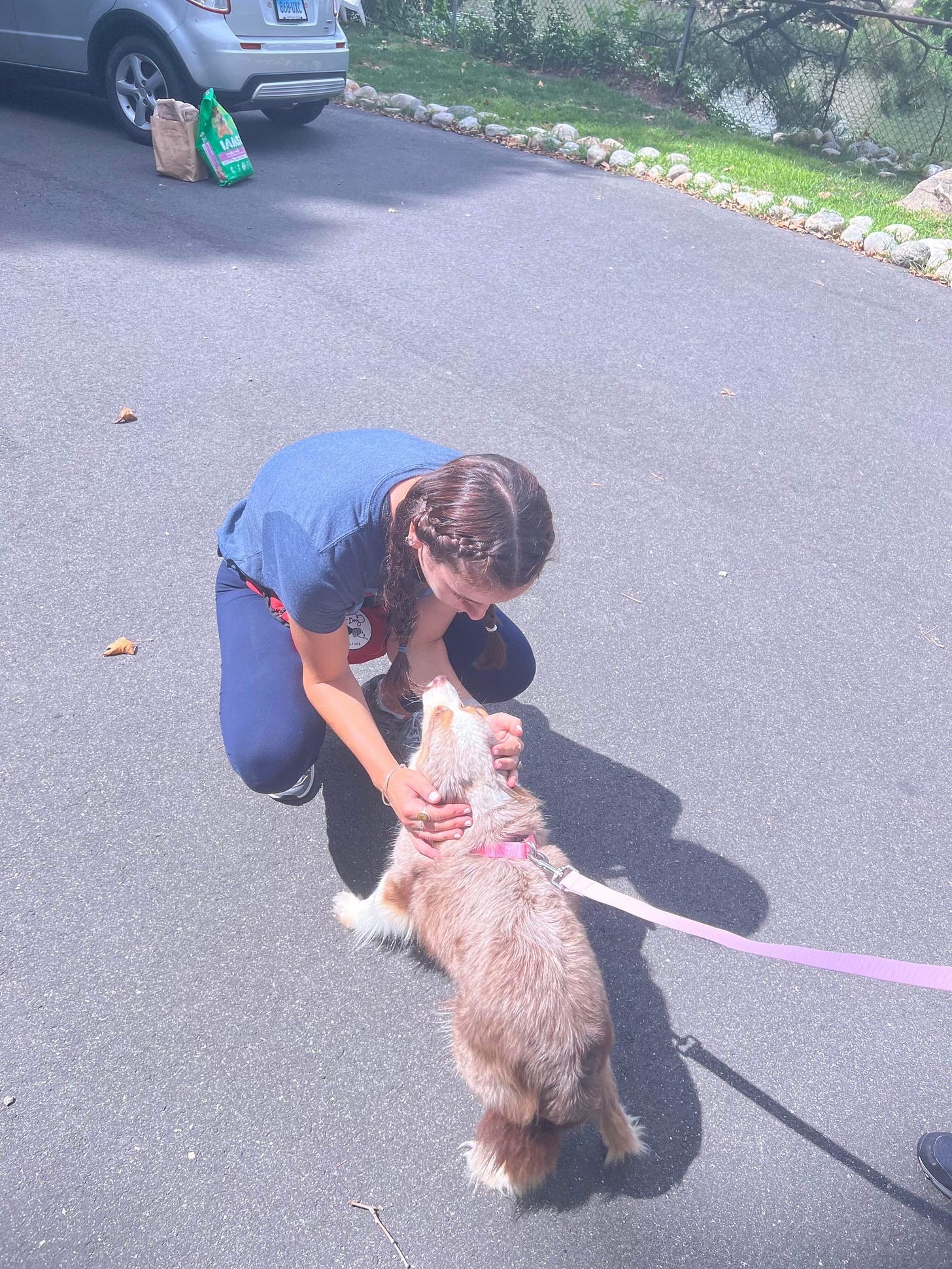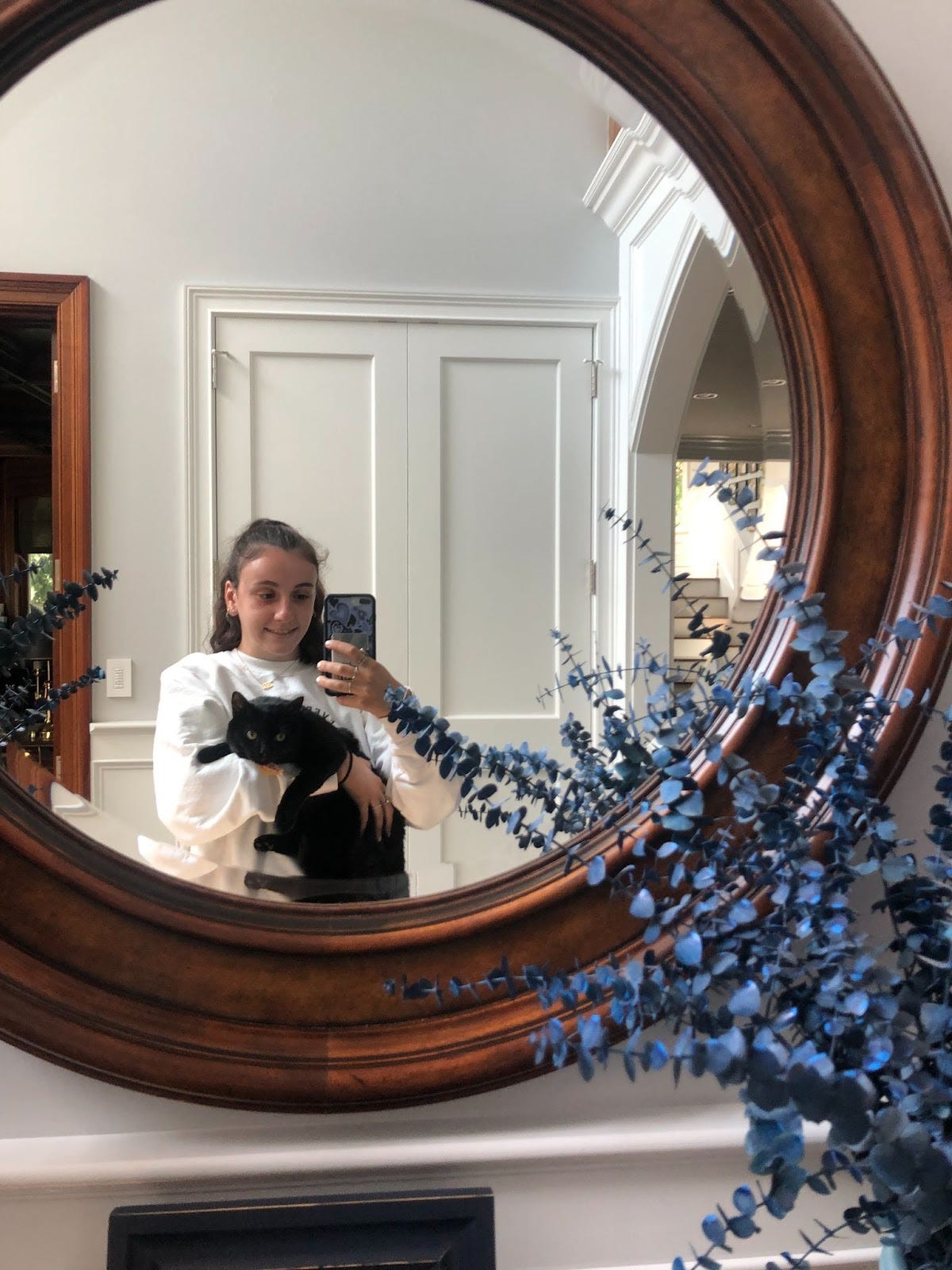Once upon a time in August 2020, I was still not quite processing the fact that my Zoom graduation meant I wasn’t going back to school like my brother, sister, and the majority of my friends.
Suddenly left alone as an adult in my childhood bedroom, I did what any sane person would do and tried to use TikTok to manifest a cat.
I was very intentional about what I wanted and why: I wanted a little black cat that reminded me of our neighbor’s pet that would always roam into our yard, and I didn’t want to be so overwhelmed and alone. (Valid question: yes, my parents were there with me but they just didn’t get the moodiness of it all, you know?)
My manifestation didn’t become a reality while I was still living at my parents’ house and so I let it go into the universe. But get this: the day after I looked around my own apartment and finally felt at home, I met a dinky little black cat in the basement who rubbed herself on the garbage and hated me…and was up for adoption.
All three dog members of our family were rescued in some way, shape, or form, so despite my parents’ very vague suggestions that I should absolutely, 100% not take in an animal at this stage of my life, reader, I brought her home.
Now, Cat (named after the no-name slob from Breakfast at Tiffany’s, thank you so much for asking) lives in the lap of luxury in the center crack of my baby pink velvet couch as she eats her way through boxes of seafood in gravy—5 floors above but eons away from her rough start neglected in a basement where she was brought in as a mouser1 and was left unfixed, unvaccinated, and untamed.2
But so many other animals don’t get the same stroke of luck that Cat did by getting stuck with me. In fact, animal welfare advocacy group Best Friends put out a press release in January stating that 100,000 more animals than last year are at risk of being put down in shelters due to the pandemic.3 October is Adopt a Shelter Dog and Pit Bull Awareness Month and while Cat is neither of these things, her story offers me a great segue into talking about the larger issues of ethical pet ownership, pet homelessness, and stigmas that still surround a number of incredible animals.
This week, in honor of her birthday on Thursday and also because she’s my personal source for animal knowledge, I talked with my sister Audrey Sharp for her hat trick episode!!!! We discussed the misconceptions about shelter and rescue pets, how everyone reading this can become animal rights advocates, and whether or not my own rescue pet will ever have her own month.4
Hi again! It’s Audrey, back for a third time on E4P to talk about another totally separate topic from my other two times, just because I like to keep people on their toes. October is Adopt a Shelter Dog and Pit Bull Awareness Month so I am here to talk a little bit about what those mean and the importance of animal welfare and rescue.
Little Miss Animal Lover
It is a truth universally acknowledged in the Sharp family that Audrey is not only the sole child to have any semblance of a scientific mind, but that she was always destined to use that mind to help animals.
I won’t lie: it has always been a little freaky to witness just how good of an animal whisperer she is. All animals just trust her immediately and entirely—even Cat who warmed up to her overnight (for reference, it took me two months of daily bonding efforts with food to even dream of bringing Cat up to my apartment from the basement).
To set the scene for everyone outside of my family, though, I asked Audi:
Emily: What is your experience working with animals?
Audrey: My experience working with animals began when I was a preteen and started dog sitting for neighbors and family friends in town. At the end of high school, I completed a volunteer internship at a local VCA emergency animal hospital. I’ve also worked at a doggy daycare and boarding facility near my college for a couple of years and have been working as part of the dog care staff at The Lucky Dog Refuge in Stamford, CT for about a year and a half now.
In the midst of that, I have continued dog sitting and volunteering inquiries and consistently get hands-on experience through my Animal Science major at school.
Emily: What are the histories behind Adopt a Shelter Dog Month and Pit Bull Awareness Month?
Audrey: Adopt a Shelter Dog Month originated in the 1980s by the American Humane Association and the ASPCA. It was developed in response to the rising numbers of household pets in shelters after private rescue organizations began taking off in the 1960s and 70s. This helped the public opinion people had of “strays” and “homeless” dogs shift to viewing them as loyal companions.
Pit Bull Awareness Month was started in 2007 by a rescue group in the South. Their motive was to bring attention to the positive truths about American Staffordshire Pit bulls. In short, the inaccurate portrayal of the breed comes from its misuse by people in the later 1900s. Pit bulls were originally known for their loyalty and human devotion but started gaining nationwide criticism for being used in dogfighting, which has hurt their image for years to come, even still today.
Emily: Why are these campaigns important to you personally?
Audrey: For as long as I could remember, my passion has always been to work with animals and to make a better world for them. These campaigns are more than a gimmick; they can seriously break very large stigmas, educate people, and can save animals' lives.
It feels weird to be pulling these statistics from an insurance company, but The Zebra recently conducted a poll about pet ownership and animal welfare and found that “34.8% of respondents believe that the breed of pit bulls are naturally more dangerous than other breeds. 52.9% believe they are just as dangerous as any other breed, while 12.3% believe they are naturally less dangerous.”
Although pit bulls and pit bull mixes only make up 6% of the US dog population, “40% of pit bulls in shelters are euthanized each year.” The ASPCA reported that 43% of dogs they track in shelters (approximately 390,000 dogs) are euthanized annually, which would mean the number of pit bulls euthanized comes in at around 156,000. These numbers prove that awareness around breed discrimination is still incredibly necessary.
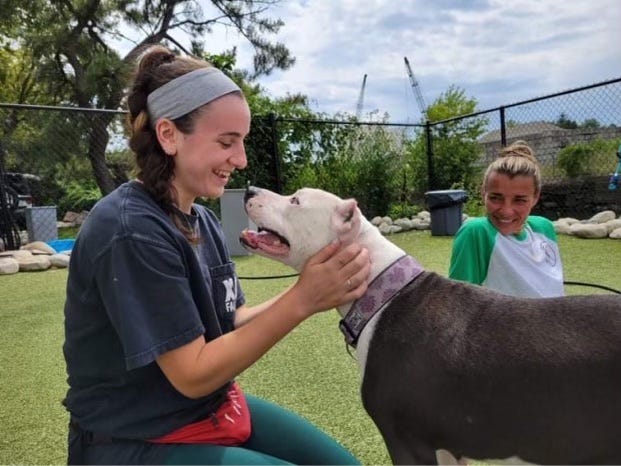
But I also started to wonder what other misconceptions we have about animals and dogs in particular.
The Washington Post reported in January that “more than 23 million American households—nearly 1 in 5 nationwide—adopted a pet during the pandemic, according to the ASPCA. Even President Biden adopted a new dog, Commander.” There are so many mixed reports about pandemic pets being returned or surrendered, but the overall consensus is that while smaller pets—such as guinea pigs, gerbils, chickens, and snakes—are being surrendered in higher numbers, larger domesticated animals— namely cats and dogs—are by and large remaining in their forever homes, with some regions showing higher rates of return than others.
Regardless of whether or not they are surrendering their animals, a lot of people who took in a pet over the past two years did not anticipate how their post-lockdown responsibilities would affect their new companions, which has led to an uptick in reports of behavioral issues.
However, animal advocates will tell us this is not just a pandemic problem. Many people have never understood what it actually takes to adopt an animal, and that often leads to a whole slew of concerns. I asked Audi:
Emily: How has the pandemic affected not only pet ownership but ethical pet ownership in particular?
Audrey: I think people adopting “COVID puppies” during the height of the pandemic was a positive outcome in one way because people began seeing the importance of adopting dogs from shelters and not buying from breeders. Shelters are businesses at the end of the day, so to be able to keep running due to the widespread increase in adoption throughout the country helped tremendously to continue to save other and more animals.
On the other side, I think people adopted dogs being in the headspace of a temporary situation and not all thought ahead. Two years later, many rescues including my own are experiencing nationwide adoption shortages following the peak of COVID. Not only that, but we are seeing an slight increase in owner surrenders from adopters who got their dogs during quarantine.
People now aren’t providing the socialization their dogs require but couldn’t get when they were puppies and, instead of dealing with the situation, they are giving up all too quickly. Some rely on trainers but are either seeking the wrong training methods, or these trainers are getting overwhelmed and overbooked and can’t take in the dog right away.
Emily: What are some things you wished people would know before adopting any animal, but a shelter dog in particular?
Audrey: People joke about their pet being their “baby” but they don’t always realize they are responsible for an actual life. Because of the lack of animal rights laws and the culture of domestication we have developed for companion animals, these animals are dependent on us for everything.
They are not an aesthetic accessory. Every dog is an individual, and needs proper training, socialization, and attention to be raised properly in their environment. What you feed them, how they’re groomed (if they even are), what you give them access to, what they’re exposed to, etc—every interaction they have matters.
This is even more relevant for shelter dogs because most come from traumatic backgrounds and have never been treated properly before or have learned to trust, so they require more behavioral attention and patience. I don’t believe every dog owner doesn’t love and care for their pet, but I think more often than not, owners are ignorant of the realities that owning a pet entails.
I think people want to find the cute, friendly, purebred golden retriever in every dog when that is rarely the case. That expectation is what harms the dog because then they aren’t given the treatment and enrichment specific to their own needs.
Emily: Do you think people have misconceptions about how protective animal rights laws are? What are the main improvements that can be made to help animals more?
Audrey: Yes. I think a lot of people are familiar with bills such as the Animal Welfare Act (AWA) and are comfortable with believing the notion that this is an umbrella of safety for animals from all areas.
However, the unfortunate truth is that there actually isn’t any one “animal rights” law. Some animals are protected under specific circumstances but a lot of the legislation are very surface level which leaves room for animal testing, neglect, and abuse, to still occur away from the spotlight because technically these people are adhering to these “laws.”
At the end of the day, animals have no rights and they are still people’s property under the law and we can do whatever we please with them. This is where grassroots campaigns and animal advocacy play a big role in helping to improve animal rights laws.
Well, I guess the first step is admitting we have a problem.
We Are In the Arms of the Angels Now!!!!
While there are a lot of conflicting numbers between organizations, I am able to say with some relative confidence that between 4.5 and 6.3 million animals will enter a shelter every year, and between 300,000 and 1 million will be euthanized (this number is down from the average 10 years ago). Those Sarah McLachlan commercials we all change the channel to avoid exist to remind us of the animals across the country who are suffering, but it is still overwhelming to find out just how dire these statistics are.
Yet, we have to keep persisting if anything is going to change. Organizations like Best Friends are working towards making every shelter and community no-kill by 2025 and advocates are working to try to engage everyone who calls themselves an animal lover in the fight for increased rights and protections for those very animals because we have to start somewhere.
I asked Audi:
Emily: Can you explain pet homelessness?
Audrey: Pet homelessness is an issue highlighting the millions of dogs and cats in the world that are strays or live in shelter settings. Contributions to pet homelessness include pet overpopulation, breed prejudices, and owner’s deficiency of necessary resources. Pet overpopulation typically is caused by the lack of spay and neutering services and unethical breeding which results in more animals in need of a shelter.
Breed prejudice is discrimination against a certain breed of dog, such as pitbulls. This is why you’ll find a higher number of pit bulls in shelters because people tend to stray away from adopting them based on false perceptions they have made up. Many charities and organizations are dedicated to helping pet homelessness for alternative reasons such as the animal’s owner being in a vulnerable situation.
The Animal Welfare Institute has developed the Safe Havens Mapping Project to provide sheltering services to help owners with pets who are in domestic violence situations. Project Street Vet and other similar non-profit charities provide free veterinary care and treatment to people without housing and who don’t have the financial means to bring their pets to the animal hospital.
Emily: What is the best way to fix the overcrowding problems so many shelters face?
Audrey: Spay and neuter, please. End unethical breeding.
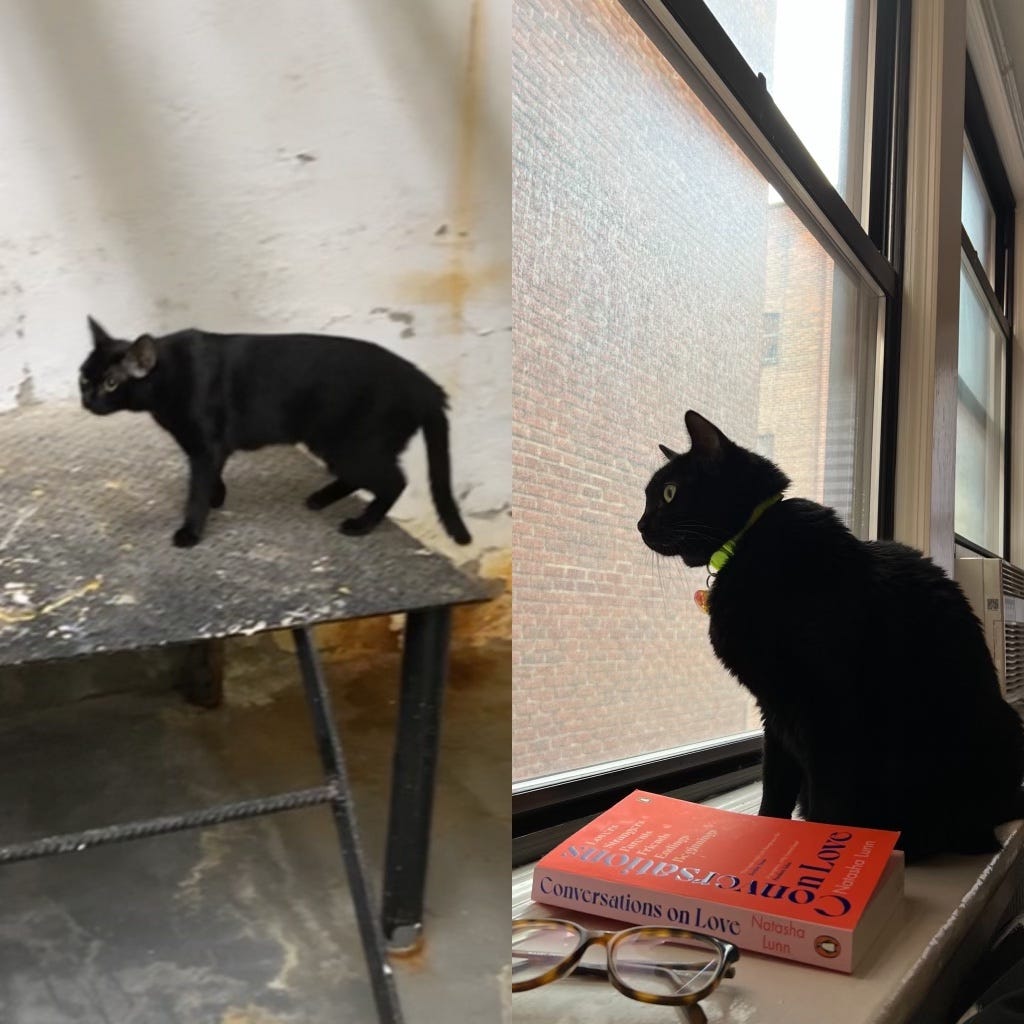
Emily: How can anyone reading this get involved to help animals even if they are unable to responsibly adopt?
Audrey: Donate, volunteer, foster, fundraise! Nonprofit organizations like animal rescues rely heavily on volunteers to keep the operation going. Getting involved in grassroots and animal advocacy campaigns are other ways to help promote animal rights.
There is so much you can do still for these animals to make a positive difference in their lives. Last year, I completed a research project based off an internship I had regarding the effects of social media on animal advocacy. There are so many areas of animal rights that can be improved, and I think social media is the highway to reaching all of those.
While I may not have the scientific mind that my sister does, I did have the privilege of editing the project and can attest to learning a lot as I went through it. It is an incredible resource for anyone interested to get involved in animal advocacy from their own homes.
For anyone in the tri-state area who is thinking about volunteering with animals, donating to a no-kill organization, or what they’re going to do on October 15th, I asked Audi:
Emily: What is Lucky Dog Refuge's mission? What is the goal for Luckypawlooza?
Audrey: Lucky Dog Refuge is a 501(c)3 nonprofit organization located in Stamford, CT. We specialize in rescuing dogs from the south that are medical cases so they require costs for things like parasite and deworming treatments, surgeries, prenatal and labor care for mothers and their litters, etc that can get expensive, especially in emergency situations.
We provide rehabilitation, veterinary care, training, and love to these animals in either fosters or our facility and adopt them out to loving forever homes typically in the Northeast area. Our facility is designed for the dogs to feel as though they are at home as opposed to traditional kennels and shelters. We also have a specialized quarantine space for dogs recently off transport and a nursery for whelping mothers and their litter. We are located in Harbor Point in Stamford so the dogs get plenty of walks and socialization around the city and get to play on our turf yard overlooking Mill River!
Luckypawlooza is our first annual fundraising festival being held in Mill River Park in Stamford, CT on October 15th, 2022 from 11am-5pm. It’s been so exciting watching this event be put together over the past few months. All proceeds from the fundraiser will go towards Lucky Dog and improvements for Mill River’s dog park. This event is so important for our rescue to promote our mission and organization, raise awareness about animal welfare, and help shelter dogs get adopted!
If you are located in or around the Southern Connecticut region, please come check out Luckypawlooza and bring your dog! All information about what specific vendors and sponsors will be attending on the Lucky Dog Refuge’s website.
I’ve seen firsthand what Lucky Dog has done for so many dogs over the past year and it is truly incredible what can be done when people act on their values and advocate on behalf of animals. Please consider getting involved here or at a shelter near you!!!
Finally, I had to ask the question on all of our minds:
Emily: Is there such a thing as Bitchy Rescue Cat Awareness Month or did Cat lie to me?
Audrey: I don’t know, but…
If you’ve ever met Cat, you know how monumental this is.
Thank you to Audrey for being so much cooler than me, and for the team at Lucky Dog and shelters around the country who are doing truly amazing work!!!!! This was a little demoralizing at parts but it was a very Audrey way to ring in her 21st birthday!!!!
No E4P next week!!!!!!
Mousers are cats who are tasked with killing mice and rats, similarly to hunting dogs. However, most cats are unable to kill rodents, especially in NYC where the rats are 10,000% on drugs. The result in Cat’s case (which I imagine is not uncommon around here) is that she was underfed because there was the assumption she would be eating rodents and unsupervised because no one wants to watch her eat rodents. The combo deal led to her being emaciated, filthy, and feral.
Because she was unfixed, she was in a battle of fertility with her sister over a third male cat. Additionally, her litter box was also rarely cleaned and her water was replenished in a moldy bowl once a week. I could go on about how mad her neglect makes me, but I’ll stop there.
Additionally, The Zebra reported that “in 2020, 32% fewer dogs and 23% fewer cats entered animal shelters, and euthanasia decreased by -44%.”
She actually already does. It’s the entire month of February and no, she does not care that that is also my birthday month as well.






